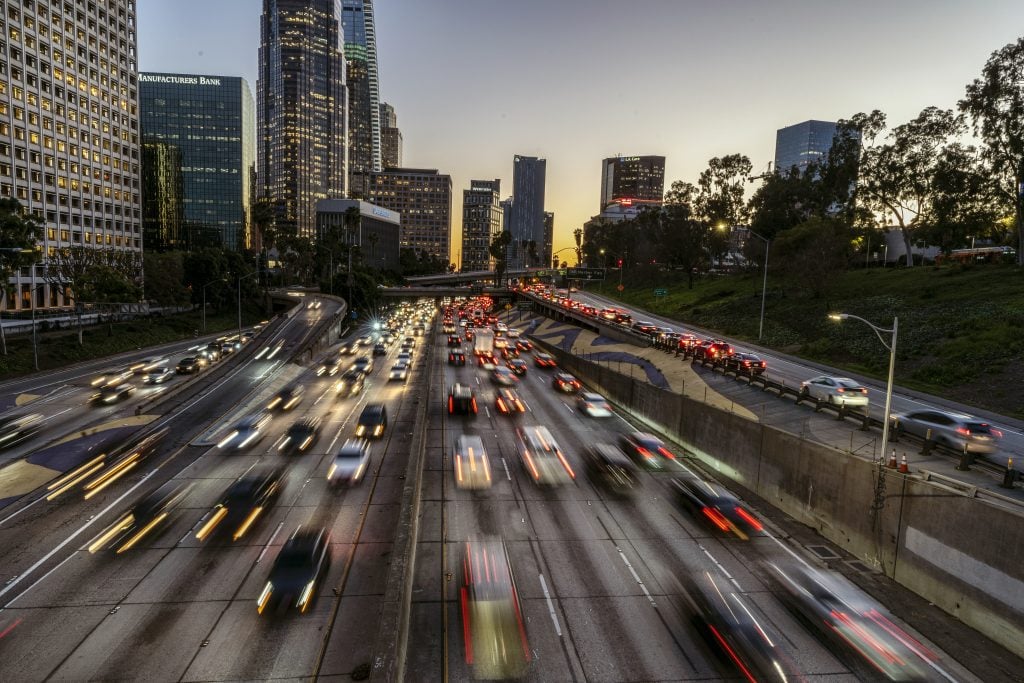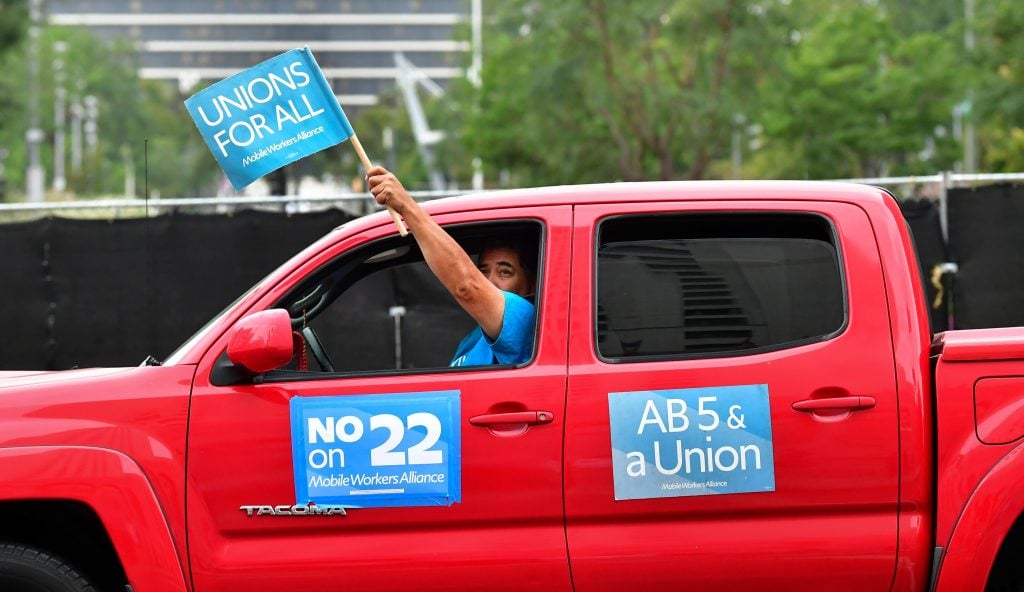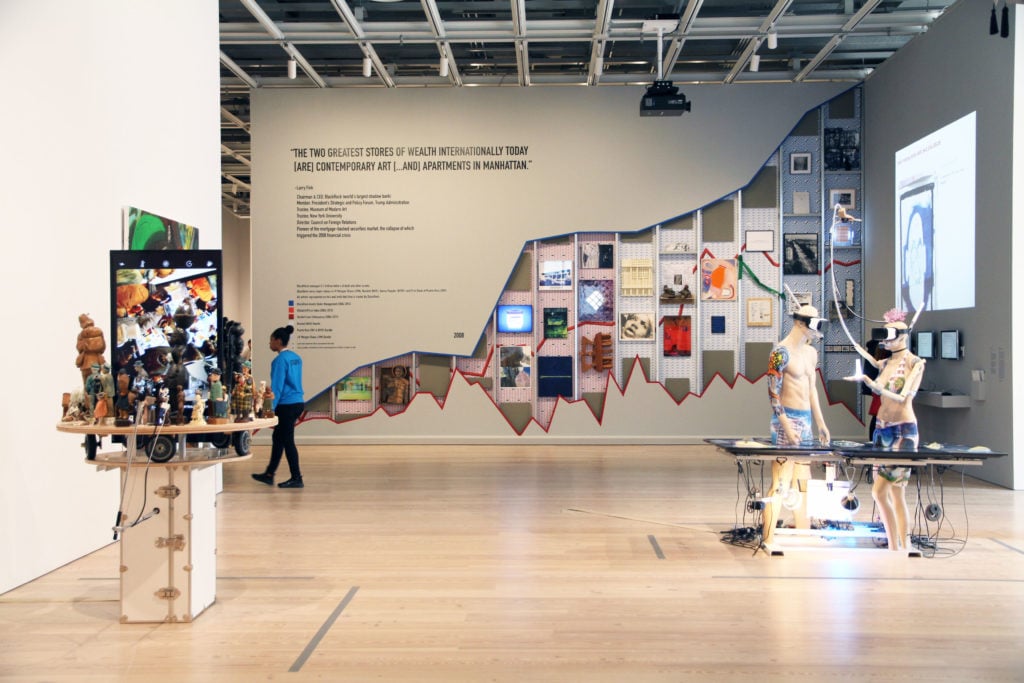Opinion
The Gray Market: Why California Voters Just Dealt an Election-Day Loss to the Entire Art World (and Other Insights)
Our columnist details the dark future for artists and arts workers presaged by the passage of California’s Proposition 22.

Our columnist details the dark future for artists and arts workers presaged by the passage of California’s Proposition 22.

Tim Schneider

Every Monday morning, Artnet News brings you The Gray Market. The column decodes important stories from the previous week—and offers unparalleled insight into the inner workings of the art industry in the process.
This week, sounding the alarm on a quiet but devastating election outcome…
On Tuesday, while much of the world frantically refreshed browser tabs and social-media feeds for updates on the US presidential election, California voters approved a ballot measure that effectively handed Silicon Valley the power to write its own labor regulations for its ride-share and delivery drivers throughout the state. The outcome doesn’t just signal deep trouble for Golden State artists and arts workers who turn to the gig economy to supplement often-volatile compensation. It also tolls an ominous bell for their counterparts across the United States, and for the art industry as a whole.

App-based drivers from Uber and Lyft protest California Proposition 22 in a caravan in front of City Hall in Los Angeles on October 22, 2020. (Photo by FREDERIC J. BROWN/AFP via Getty Images)
Known as Proposition 22, the measure sought to counteract a 2018 California Supreme Court ruling and 2019 state legislation that would have required Uber, Lyft, DoorDash, and others to classify their drivers as employees entitled to minimum-wage guarantees, health insurance, and other benefits. The companies portrayed these shifts in labor law as damaging to all sides of the transactions their apps enable, arguing that the regulations would strip drivers of the flexibility that many cite as the greatest advantage of gig work, raise prices and lengthen wait times for customers, and plunge Silicon Valley into an expensive and unnecessary compliance labyrinth.
Instead, Prop 22 asked California voters to give Big Tech the ability to define its drivers (or, as Uber prefers to call them, its “driver partners”) as independent contractors only deserving what I would call a liquid-diet version of labor protections. The Los Angeles Times editorial board summarized the meager benefits that Prop 22 would usher in as follows: “a wage floor that translates into about 20 percent less than the state minimum” (a calculation Uber and Lyft dispute), “insurance that covers [drivers] to some degree in the case of on-the-job injury or death, and the chance to earn subsidies for health insurance. It’s not nothing.”
I might be able to produce a more efficient summary of the entire gig economy’s value to workers in 2020 than “it’s not nothing,” but only in the sense that I might be able to find my way back to civilization alive if you air-dropped me naked into the frozen tundra of the Rocky Mountains this winter. I think we’re all much better off if we just don’t shake things up.
To my dismay, refusing to shake things up is essentially what California voters did at the ballot box on Election Day, too. Prop 22 passed by a not-even-close margin of 58 percent to 42 percent. As a result, the next logical question concerns the scope of the damage it will do to the most vulnerable laborers inside and outside the art economy.

Occupy Museums, Debtfair (2017). Photo: Henri Neuendorf.
With the resources I have, it’s nearly impossible to quantify how many artists and arts workers in California double as drivers for Silicon Valley ventures. However, circumstantial evidence suggests that the number is large, particularly during the epochal crisis we’re weathering now.
According to an April 2019 study by the National Endowment for the Arts, 34.1 percent of US artists were self-employed for the five-year period from 2012 through 2016, compared to just 9.4 percent of the general labor force. Although the NEA’s definition of “artist” aggregates everything from fine artists and dancers, to set designers and editors, to architects and musicians (and more), the organization singles out two sub-groups as having “especially high” proportions of self-employment: photographers, at roughly 56 percent; and fine artists, at roughly 54 percent. In other words, these creative professionals are about six times more likely than the average American worker to go without a salaried position, let alone other benefits that might come with a regular job.
Now, it would be reasonable to conclude that some number of these same artists were already making extra cash by moonlighting as drivers in the gig economy even before the Great Shutdown of March 2020. But their ranks balloon once you factor in how deadly the crisis has been to the types of employment where artists have frequently flocked on a part-time basis. After analyzing recent government data, the Washington Post concluded the following in early October:
Nine of the 10 hardest-hit industries in the coronavirus recession are services. They include performing arts, sightseeing, hotels, transportation, clothing retail, and museums. Economists worry that many of these jobs will not return, with restaurants and entertainment venues going out of business.
As I wrote in response to the Post’s findings, NEA data from 2013 estimated that somewhere between 30 percent and 60 percent of moonlighting artists held day jobs in the service sector or “educational and health services,” with the latter category including art schools and (likely) museums and other arts nonprofits. Surely, many more of those artists have had no choice but to start driving for Uber or delivering takeout for DoorDash thanks to the upheaval.
The bad news nationally is even worse for California artists. Due in part to the way the state has classified art museums in its reopening plan, many institutions, including the J. Paul Getty Museum, the Hammer, and the Museum of Contemporary Art, have been closed since the spring. MOCA and the Hammer also laid off nearly 250 part-time employees combined in March. Up north, the San Francisco Museum of Modern Art is welcoming visitors again, but it laid off nearly 150 on-call and full-time members of its staff this year. That’s a lot of carnage for one state’s cultural labor force.
Meanwhile, the commercial sector is under duress inside and outside the Golden State’s borders. In an Art Newspaper survey of 40 “small to midsize galleries across the US” conducted last month, about 75 percent of respondents reported they face “severe financial hardship or even closure within the next year without more monetary aid” from government coffers. The turbulence has lead to an ongoing yet unknowable campaign of cost cutting and reduced activity that, along with the losses in the institutional sphere, undoubtedly thrusts hundreds, if not thousands, of artists and arts workers into the gig economy, where Prop 22 will now help ensure that they earn “not nothing”… but not much more.
Worst of all, with Uber CEO Dara Khosrowshahi already stating in his latest earnings call that the company will now push for Prop 22-like measures in more states, these dark tidings for desperate artists and arts workers won’t be contained to the west coast for long. Going further, many industry analysts now expect Big Tech to push for overarching legislation to enshrine gig workers as independent contractors nationwide.
Could the art industry help rescue itself and its workforce by following Silicon Valley’s lead at the ballot box in key states, though? Not likely, as the details of Big Tech’s successful campaign on Prop 22 make clear.

Uber CEO Dara Khosrowshahi at a conference held by the École Polytechnique in 2018. © École Polytechnique – J.Barande. Courtesy of Wikimedia Commons.
I do not want to downplay the diligent, ongoing, admirable work being done by museums, dealers, their professional associations, and other related parties at the state and local levels, such as the joint quest for rent relief pursued by the Art Dealers Association of America and the New Art Dealers Alliance. But I do want to illuminate the galactic expanse separating the art world’s lobbying resources from Silicon Valley’s.
To me, saying the art world is at a disadvantage to Big Tech on lobbying is an understatement on the order of saying the average Gotham City pickpocket is at a disadvantage to Batman. Uber and Lyft alone funneled more than $200 million into promoting Prop 22’s approval, according to the LA Times. This spending spree enabled a seemingly never-ending monsoon of TV spots, billboards, and mass mailings urging Californians to vote yes on the initiative for months leading up to Election Day.
Even more eye-opening than the financial disparity, however, was the direct line of communication Silicon Valley had to California residents via the apps themselves. Here’s Alissa Walker in Curbed, from her appropriately headlined cannonade “Uber and Lyft Just Bought a Law in California”:
Uber and Lyft—as well as other driver-based delivery services like DoorDash—started using their apps, which are installed on the phones of millions of California voters, to send push notifications and in-app messages warning of longer wait times, much higher prices, and dire economics for drivers if Prop 22 failed. Riders had to confirm receipt of all of this information before they could book trips.
Together, Big Tech’s deep pockets, broad access, and close coordination comprise everything that the art industry lacks when it comes to advancing helpful industry-specific laws or stimulus measures. Our weird professional niche has no hope of mustering anything close to a $200 million war chest or a direct line of communication to millions of voters. Nor are its various constituents even necessarily seeking the same remedies. For instance, consider the blue-chip dealers and collectors lobbying for the federal government to reinstate the 1031 exchange that provided a workaround for capital gains taxes on investment-grade art transactions—a rule change irrelevant to the majority of dealers working with modestly priced emerging and mid-career artists.
So while Big Tech leverages unparalleled money and power to laser-focus the public on a common-cause issue, the art industry must pin its hopes for legislative assistance on the slog of grassroots organizing and coalition-building. These twin realities endanger millions of vulnerable workers overall, as well as thousands with a professional stake in the arts.
It’s a hard reality to stomach. Regardless of the moving vans headed to the White House, it means we’ve got a lot of work to do.
[Curbed]
That’s all for this week. ‘Til next time, remember: before you let anyone take the wheel, you should make damn sure they actually have your best interests at heart.